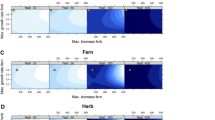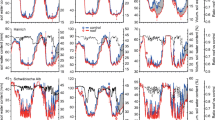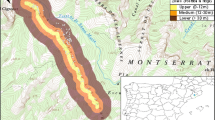Abstract
Severe drought events increasingly affect forests worldwide, but little is known about their long-term effects at the ecosystem level. Competition between trees and herbs (‘overstorey–understorey competition’) for soil water can reduce tree growth and regeneration success and may thereby alter forest structure and composition. However, these effects are typically ignored in modelling studies. To test the long-term impact of water competition by the herbaceous understorey on forest dynamics, we incorporated this process in the dynamic forest landscape model LandClim. Simulations were performed both with and without understorey under current and future climate scenarios (RCP4.5 and RCP8.5) in a drought-prone inner-Alpine valley in Switzerland. Under current climate, herbaceous understorey reduced tree regeneration biomass by up to 51%, particularly in drought-prone landscape positions (i.e., south-facing, low-elevation slopes), where it also caused a shift in forest composition towards drought-tolerant tree species (for example, Quercus pubescens). For adult trees, the understorey had a minor effect on growth. Under future climate change scenarios, increasing drought frequency and intensity resulted in large-scale mortality of canopy trees, which intensified the competitive interaction between the understorey and tree regeneration. At the driest landscape positions, a complete exclusion of tree regeneration and a shift towards an open, savannah-like vegetation occurred. Overall, our results demonstrate that water competition by the herbaceous understorey can cause long-lasting legacy effects on forest structure and composition across drought-prone landscapes, by affecting the vulnerable recruitment phase. Ignoring herbaceous vegetation may thus lead to a strong underestimation of future drought impacts on forests.







Similar content being viewed by others
References
Adams HR, Barnard HR, Loomis AK. 2014. Topography alters tree growth-climate relationships in a semi-arid forested catchment. Ecosphere 5:1–16.
Allen CD, Macalady AK, Chenchouni H, Bachelet D, McDowell N, Vennetier M, Kitzberger T, Rigling A, Breshears DD, Hogg EH, Gonzalez P, Fensham R, Zhang Z, Castro J, Demidova N, Lim JH, Allard G, Running SW, Semerci A, Cobb N. 2010. A global overview of drought and heat-induced tree mortality reveals emerging climate change risks for forests. For Ecol Manage 259:660–84.
Anderegg WRL, Anderegg LDL, Sherman C, Karp DS. 2012. Effects of widespread drought-induced aspen mortality on understory plants. Conserv Biol 26:1082–90.
Anderegg WRL, Kane JM, Anderegg LDL. 2013. Consequences of widespread tree mortality triggered by drought and temperature stress. Nat Clim Change 3:30–6.
Anderegg WRL, Schwalm C, Biondi F, Camarero JJ, Koch G, Litvak M, Ogle K, Shaw JD, Shevliakova E, Williams AP, Wolf A, Ziaco E, Pacala S. 2015. Pervasive drought legacies in forest ecosystems and their implications for carbon cycle models. Science 349:528–32.
Balandier P, Collet C, Miller JH, Reynolds PE, Zedaker SM. 2006. Designing forest vegetation management strategies based on the mechanisms and dynamics of crop tree competition by neighbouring vegetation. Forestry 79:3–27.
Baldocchi DD, Law BE, Anthoni PM. 2000. On measuring and modeling energy fluxes above the floor of a homogeneous and heterogeneous conifer forest. Agric For Meteorol 102:187–206.
Baldocchi DD, Xu LK, Kiang N. 2004. How plant functional-type, weather, seasonal drought, and soil physical properties alter water and energy fluxes of an oak-grass savanna and an annual grassland. Agric For Meteorol 123:13–39.
Bigler C, Braker OU, Bugmann H, Dobbertin M, Rigling A. 2006. Drought as an inciting mortality factor in Scots pine stands of the Valais, Switzerland. Ecosystems 9:330–43.
Black TA, Kelliher FM. 1989. Processes controlling understorey evapotranspiration. Philos Trans R Soc Lond Ser B Biol Sci 324:207–31.
Bugmann H. 2001. A review of forest gap models. Clim Change 51:259–305.
Bugmann H, Cramer W. 1998. Improving the behaviour of forest gap models along drought gradients. For Ecol Manage 103:247–63.
Cáceres MD, Martínez-Vilalta J, Coll L, Llorens P, Casals P, Poyatos R, Pausas JG, Brotons L. 2015. Coupling a water balance model with forest inventory data to predict drought stress: the role of forest structural changes vs. climate changes. Agric For Meteorol 213:77–90.
Clark JS, Iverson L, Woodall CW, Allen CD, Bell DM, Bragg DC, D’Amato AW, Davis FW, Hersh MH, Ibanez I, Jackson ST, Matthews S, Pederson N, Peters M, Schwartz MW, Waring KM, Zimmermann NE. 2016. The impacts of increasing drought on forest dynamics, structure, and biodiversity in the United States. Glob Change Biol 22:2329–52.
Constantin J, Grelle A, Ibrom A, Morgenstern K. 1999. Flux partitioning between understorey and overstorey in a boreal spruce/pine forest determined by the eddy covariance method. Agric For Meteorol 98–9:629–43.
Dai AG. 2013. Increasing drought under global warming in observations and models. Nat Clim Change 3:52–8.
Davis MA, Wrage KJ, Reich PB. 1998. Competition between tree seedlings and herbaceous vegetation: support for a theory of resource supply and demand. J Ecol 86:652–61.
Elkin C, Giuggiola A, Rigling A, Bugmann H. 2015. Short- and long-term efficacy of forest thinning to mitigate drought impacts in mountain forests in the European Alps. Ecol Appl 25:1083–98.
Elkin C, Gutierrez AG, Leuzinger S, Manusch C, Temperli C, Rasche L, Bugmann H. 2013. A 2 degrees C warmer world is not safe for ecosystem services in the European Alps. Glob Change Biol 19:1827–40.
Federer CA. 1982. Transpirational supply and demand: plant, soil, and atmospheric effects evaluated by simulation. Water Resour Res 18:355–62.
Galiano L, Martinez-Vilalta J, Eugenio M, Granzow-de la Cerda I, Lloret F. 2013. Seedling emergence and growth of Quercus spp. following severe drought effects on a Pinus sylvestris canopy. J Veg Sci 24:580–8.
George LO, Bazzaz FA. 1999. The fern understory as an ecological filter: emergence and establishment of canopy-tree seedlings. Ecology 80:833–45.
Gerten D, Schaphoff S, Haberlandt U, Lucht W, Sitch S. 2004. Terrestrial vegetation and water balance—hydrological evaluation of a dynamic global vegetation model. J Hydrol 286:249–70.
Gilliam FS. 2007. The ecological significance of the herbaceous layer in temperate forest ecosystems. Bioscience 57:845–58.
Giuggiola A. 2016. Impact of forest management on the drought resistance of dry pine forests. Ph.D. Thesis No. 22802. ETH-Zurich. Zurich, p 214.
Giuggiola A, Bugmann H, Zingg A, Dobbertin M, Rigling A. 2013. Reduction of stand density increases drought resistance in xeric Scots pine forests. For Ecol Manage 310:827–35.
Gobin R, Korboulewsky N, Dumas Y, Balandier P. 2015. Transpiration of four common understorey plant species according to drought intensity in temperate forests. Ann For Sci 72:1053–64.
Halpern CB, Lutz JA. 2013. Canopy closure exerts weak controls on understory dynamics: a 30-year study of overstory-understory interactions. Ecol Monogr 83:221–37.
Hanewinkel M, Cullmann DA, Schelhaas MJ, Nabuurs GJ, Zimmermann NE. 2013. Climate change may cause severe loss in the economic value of European forest land. Nat Clim Change 3:203–7.
Henne PD, Elkin C, Franke J, Colombaroli D, Calò C, La Mantia T, Pasta S, Conedera M, Dermody O, Tinner W. 2015. Reviving extinct Mediterranean forest communities may improve ecosystem potential in a warmer future. Front Ecol Environ 13:356–62.
Henne PD, Elkin CM, Reineking B, Bugmann H. 2011. Did soil development limit spruce (Picea abies) expansion in the Central Alps during the Holocene? Testing a palaeobotanical hypothesis with a dynamic landscape model. J Biogeogr 38:933–49.
Iida S, Ohta T, Matsumoto K, Nakai T, Kuwada T, Kononov AV, Maximov TC, van der Molen MK, Dolman H, Tanaka H, Yabuki H. 2009. Evapotranspiration from understory vegetation in an eastern Siberian boreal larch forest. Agric For Meteorol 149:1129–39.
Jackson RB, Canadell J, Ehleringer JR, Mooney HA, Sala OE, Schulze ED. 1996. A global analysis of root distributions for terrestrial biomes. Oecologia 108:389–411.
Jarosz N, Brunet Y, Lamaud E, Irvine M, Bonnefond JM, Loustau D. 2008. Carbon dioxide and energy flux partitioning between the understorey and the overstorey of a maritime pine forest during a year with reduced soil water availability. Agric For Meteorol 148:1508–23.
Joffre R, Rambal S. 1993. How tree cover influences the water-balance of Mediterranean rangelands. Ecology 74:570–82.
Johnstone JF, McIntire EJB, Pedersen EJ, King G, Pisaric MJF. 2010. A sensitive slope: estimating landscape patterns of forest resilience in a changing climate. Ecosphere 1:1–21.
Knoop W, Walker B. 1985. Interactions of woody and herbaceous vegetation in a southern African savanna. J Ecol 73:235–53.
McCarthy BC. 2003. The herbaceous layer of eastern old-growth deciduous forests. In: Gilliam FS, Roberts MR, Eds. The herbaceous layer in forests of eastern North America. New York: Oxford University Press. p 163–76.
McCarthy BC, Small CJ, Rubino DL. 2001. Composition, structure and dynamics of Dysart Woods, an old-growth mixed mesophytic forest of southeastern Ohio. For Ecol Manage 140:193–213.
Moreno G, Obrador JJ, Cubera E, Dupraz C. 2005. Fine root distribution in dehesas of central-western Spain. Plant Soil 277:153–62.
Morris LA, Moss SA, Garbett WS. 1993. Competitive interference between selected herbaceous and woody plants and Pinus taeda L. during two growing seasons following planting. For Sci 39:166–87.
Moser B, Temperli C, Schneiter G, Wohlgemuth T. 2010. Potential shift in tree species composition after interaction of fire and drought in the Central Alps. Eur J Forest Res 129:625–33.
Nambiar EKS, Sands R. 1993. Competition for water and nutrients in forests. Can J For Res 23:1955–68.
Nelson AS, Weiskittel AR, Wagner RG, Saunders MR. 2014. Development and evaluation of aboveground small tree biomass models for naturally regenerated and planted species in eastern Maine, U.S.A. Biomass Bioenerg 68:215–27.
Niinemets U. 2010. A review of light interception in plant stands from leaf to canopy in different plant functional types and in species with varying shade tolerance. Ecol Res 25:693–714.
Patsias K, Bruelheide H. 2013. Climate change—bad news for montane forest herb layer species? Acta Oecol 50:10–19.
Picon-Cochard C, Coll L, Balandier P. 2006. The role of below-ground competition during early stages of secondary succession: the case of 3-year-old Scots pine (Pinus sylvestris L.) seedlings in an abandoned grassland. Oecologia 148:373–83.
Provendier D, Balandier P. 2008. Compared effects of competition by grasses (Graminoids) and broom (Cytisus scoparius) on growth and functional traits of beech saplings (Fagus sylvatica). Ann For Sci 65:510.
R Development Core Team. 2016. R: a language and environment for statistical computing. Vienna: R Foundation for Statistical Computing.
Rajczak J, Kotlarski S, Salzmann N, Schar C. 2016. Robust climate scenarios for sites with sparse observations: a two-step bias correction approach. Int J Climatol 36:1226–43.
Richardson B. 1993. Vegetation management-practices in plantation forests of Australia and New-Zealand. Can J For Res 23:1989–2005.
Rigling A, Bigler C, Eilmann B, Feldmeyer-Christe E, Gimmi U, Ginzler C, Graf U, Mayer P, Vacchiano G, Weber P, Wohlgemuth T, Zweifel R, Dobbertin M. 2013. Driving factors of a vegetation shift from Scots pine to pubescent oak in dry Alpine forests. Glob Change Biol 19:229–40.
Rigling A, Braker O, Schneiter G, Schweingruber F. 2002. Intra-annual tree-ring parameters indicating differences in drought stress of Pinus sylvestris forests within the Erico-Pinion in the Valais (Switzerland). Plant Ecol 163:105–21.
Roberts J, Pymar CF, Wallace JS, Pitman RM. 1980. Seasonal changes in leaf area, stomatal and canopy conductances and transpiration from bracken below a forest canopy. J Appl Ecol 17:409–22.
Royo AA, Carson WP. 2006. On the formation of dense understory layers in forests worldwide: consequences and implications for forest dynamics, biodiversity, and succession. Can J For Res 36:1345–62.
Saura-Mas S, Bonas A, Lloret F. 2015. Plant community response to drought-induced canopy defoliation in a Mediterranean Quercus ilex forest. Eur J Forest Res 134:261–72.
Schaap MG, Bouten W. 1997. Forest floor evaporation in a dense Douglas fir stand. J Hydrol 193:97–113.
Schuler LJ, Bugmann H, Snell RS. 2016. From monocultures to mixed-species forests: is tree diversity key for providing ecosystem services at the landscape scale? Landscape Ecol 32:1499–516.
Schulze ED, Beck E, Müller-Hohenstein K. 2005. Plant ecology. Berlin: Springer. p 702p.
Schumacher S. 2004. The role of large-scale disturbances and climate for the dynamics of forested landscapes in the European Alps. Ph.D. Thesis No. 15573. ETH Zurich, p 141.
Schumacher S, Bugmann H. 2006. The relative importance of climatic effects, wildfires and management for future forest landscape dynamics in the Swiss Alps. Glob Change Biol 12:1435–50.
Schumacher S, Bugmann H, Mladenoff D. 2004. Improving the formulation of tree growth and succession in a spatially explicit landscape model. Ecol Model 180:175–94.
Schwörer C, Fisher DM, Gavin DG, Temperli C, Bartlein PJ. 2016. Modeling postglacial vegetation dynamics of temperate forests on the Olympic Peninsula (WA, USA) with special regard to snowpack. Clim Change 137:379–94.
Suarez ML, Kitzberger T. 2008. Recruitment patterns following a severe drought: long-term compositional shifts in Patagonian forests. Can J For Res 38:3002–10.
Thrippleton T, Bugmann H, Kramer-Priewasser K, Snell RS. 2016. Herbaceous understorey: an overlooked player in forest landscape dynamics? Ecosystems 19:1240–54.
Thrippleton T, Dolos K, Perry GLW, Groeneveld J, Reineking B. 2014. Simulating long-term vegetation dynamics using a forest landscape model: the post-Taupo succession on Mt Hauhungatahi, North Island, New Zealand. N Z J Ecol 38:26–43.
Wagner RG, Little KM, Richardson B, McNabb K. 2006. The role of vegetation management for enhancing productivity of the world’s forests. Forestry 79:57–79.
Ward D, Wiegand K, Getzin S. 2013. Walter’s two-layer hypothesis revisited: back to the roots!. Oecologia 172:617–30.
Wolf A. 2011. Estimating the potential impact of vegetation on the water cycle requires accurate soil water parameter estimation. Ecol Model 222:2595–605.
Zou CB, Barron-Gafford GA, Breshears DD. 2007. Effects of topography and woody plant canopy cover on near-ground solar radiation: Relevant energy inputs for ecohydrology and hydropedology. Geophys Res Lett 34:1–6.
Acknowledgements
We are grateful for the support by Dominic Michel in all IT-related questions. Denis Loustau kindly provided biological data from the study site Le Bray. We furthermore thank Maxime Cailleret, Sebastian Wolf, Arnaud Giuggiola, Nica Huber and Laura Schuler for their helpful input. Funding for Rebecca S. Snell was provided by the EU FP7 Project ‘IMPRESSIONS’, Grant No. 603416.
Author information
Authors and Affiliations
Corresponding author
Additional information
Author’s Contribution
T.T., R.S.S. and H.B. designed the study; T.T., M.F. and R.S.S. developed the submodel; T.T. conducted the simulation experiments; T.T., H.B. and R.S.S. wrote the paper.
The URL to the model LandClim, which our publication is based on, is: https://uwis-server102.ethz.ch/openaccess/software/view/2.
Electronic supplementary material
Below is the link to the electronic supplementary material.
Rights and permissions
About this article
Cite this article
Thrippleton, T., Bugmann, H., Folini, M. et al. Overstorey–Understorey Interactions Intensify After Drought-Induced Forest Die-Off: Long-Term Effects for Forest Structure and Composition. Ecosystems 21, 723–739 (2018). https://doi.org/10.1007/s10021-017-0181-5
Received:
Accepted:
Published:
Issue Date:
DOI: https://doi.org/10.1007/s10021-017-0181-5




